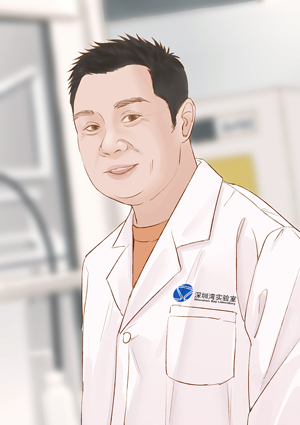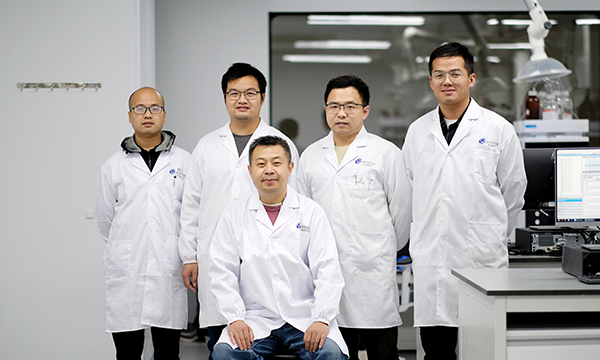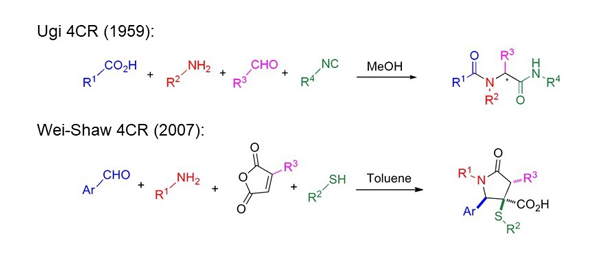
For a new drug, from target identification and biomarker selection to compound synthesis, lead optimization, and preclinical candidate selection, and then to clinical trials and its final approval, every step in its discovery and development is embedded with thorns. In this arduous journey with more failures than success, Dr. Jingqiang Wei has always maintained a high degree of enthusiasm, courage of not being afraid of failure, and clinging perseverance. Just like his motto CHEM-IS-TRY, he believes that only after thousands of trials and setbacks can we truly see the light of day and bring the hope of life to patients in need.

The Center of Translational Research, Shenzhen Bay Laboratory
Senior researcher in translational research
Research areas:
Engaged in the discovery and development of small-molecule drugs; focusing on the fields of cancer, metabolism and cardiovascular, and neurodegenerative diseases; quickly and efficiently obtaining Preclinical Candidate (PCC), Clinical Application of Investigational New Drug (IND) Candidate and Clinical Candidate by means of modern medicinal chemistry; research interests include organic chemistry, chemical biology, and medicinal chemistry.
I was born in Shandong Province and graduated from Beijing University of Chemical Technology in 1995. After graduation, I went back to my hometown and worked in a chemical plant. At that time, the industry was undergoing adjustment and the future was uncertain. After careful consideration, I chose to study for a master’s degree from then Institute of Photographic Chemistry, Chinese Academy of Sciences, returning to scientific research and looking for my direction. It was a peak period of studying abroad around the year 2000 and many students went abroad for further studies. At the time, I didn't think too much but felt that since I chose the way of the scientific research, I should insist on it, so I went to Iowa State University in the US for my Ph.D. degree, and continued my postdoctoral research at Harvard University.
My first project during my postdoc period was a synthetic chemistry project. At that time, my advisor discovered a completely new reaction and wanted to apply this new method to the synthesis of natural products and compound libraries. In the process of making a compound library, I found that this reaction has some special phenomenon, which is different from the mechanism described by my advisor. After discussion, he also supported me to continue to explore the mechanism of this reaction. Then I found this stereo-selective four-component reaction after repeated experiments. The four-component reaction is relatively rare in the history of chemistry. The other discovery of the four-component Ugi reaction (Ugi-4CR) was in the late 1950s, so our work was considered an important breakthrough. After the paper was published, it was written in the graduate student textbooks of the Department of Chemistry and Chemical Biology at Harvard University. This work gave me great encouragement and recognition. One year later, through the recommendation of my advisor, I joined the Therapeutic Platform of Broad Institute, which was newly established by Harvard University and Massachusetts Institute of Technology, to engage in translational research.
Translational medicine is a discipline that has only emerged in the past ten years. I remember that when our therapeutic platform was first established in 2008, many professors from Harvard and Massachusetts Institute of Technology held different opinions, believing that this is what the industry should do. Now we have gradually formed a consensus that new drug discovery requires academia, industry, and financing collaboration. The the industry work should extend to basic research area, and the academic community should carry out extensive cooperation with pharmaceutical companies and investment companies. Certainly, such a consensus is just the beginning, and we still have a long way to go.
In retrospect, both basic scientific research and translational research require great enthusiasm, especially, the success rate of new drug discovery is very low, so we should not fear challenges and failures. There are usually two types of difficulties in the pharmaceutical process, one is scientific problems, for example, if the drug target is not validated, or the mechanism of the disease is different from the hypothesis, the project would not be advanced. Even if it was pushed to the stage of clinical trial stage, it would likely fail; The other is the business-related problem. If the progress of the new drug project is far behind your competitors and the data didn’t show advantages, the company would consider terminating the project from a commercial perspective. So when we are still working on a project, we must try our best to move it as fast as we can.
After leaving the Broad Institute, I worked for another six years at GlaxoSmithKline (GSK) and a start-up company in Boston, accumulating more experience in drug discovery. In 2020, I returned to China and joined the Center for Translational Research at Shenzhen Bay Laboratory. In the laboratory, my main research area is medical chemistry, engaging in the discovery and development of small-molecule drugs.
When I was at school, medicinal chemistry was not a very popular subject in academia. Not every school would offer a Medicinal Chemistry major, which is mainly to study chemical compounds’ structure and biological activity from molecular level. In fact, a large number of researchers with medicinal chemistry backgrounds are needed in the industry, especially in the pharmaceutical field. In recent years, with the rise of translational medicine, modern medicinal chemistry has increasingly become an important basis for small molecule drug discovery.
Medicinal chemistry plays a central role in small-molecule new drug discovery projects. From target validation, compound screening to drug manufacturing production, and clinical application, it runs through the entire drug discovery and development process, connecting multiple disciplines. The projects of the Center for Translational Research cover cancer, cardiovascular diseases, metabolic diseases, and neurological diseases, etc. Therefore, we are conducting interdisciplinary cooperation with multiple research teams in the laboratory.
Shenzhen Bay Laboratory has a new model, new strategy, and strong scientific research background, and the layout of translational research is also at the right time. I hope we can work together to build the Center for Translational Research into a high level and high productive platform that continuously produces drug candidates for clinical trials and eventually approved drugs on market, which can play a leading role in promoting the new drug research and development industry for the region and even the nation, and really help patients in need.

Brief introduction of the team leader:
Before joining Shenzhen Bay Laboratory, Dr. Wei Jingqiang worked on the application of artificial intelligence and quantum computing in drug design at Silicon Therapeutics. The company was acquired by Roivant Sciences in 2021 with $450 million upfront payment and future commercial milestone. At GSK, he is committed to the development of DNA Encoding Library (DEL) technology and its application in medicinal chemistry programs. At Broad Institute, he participated in the founding of the Chemical Biology Platform and the Therapeutic Platform, completed the synthesis of more than 100,000 new diversity compounds and multiple project screenings through high-throughput chemistry, and cooperated with several pharmaceutical companies for translational research. During his postdoctoral research at Harvard University, he independently discovered a new stereo-selective four-component reaction, which was reported by Nature, C&EN.

References:
Jingqiang Wei, Jared T. Shaw. Diastereoselective Synthesis of γ-Lactams by a One-Pot, Four-Component Reaction. Organic Letters. 2007, 9(20), 4077-4080 (Highlighted by Nature. 2007, 449,119; Reported by C&EN. 2007, 85(38), 64)













